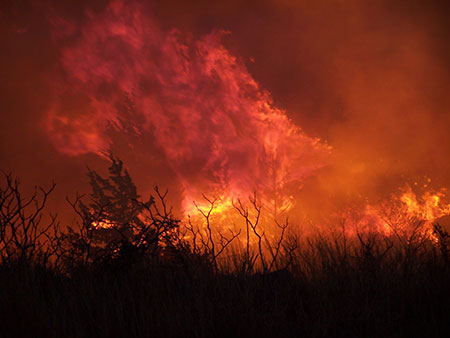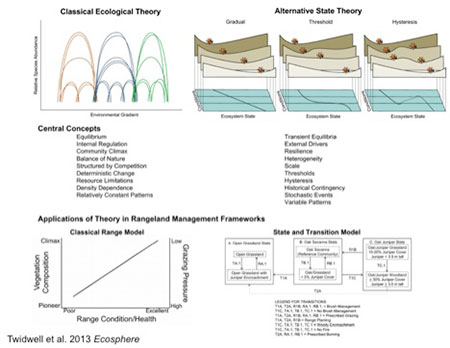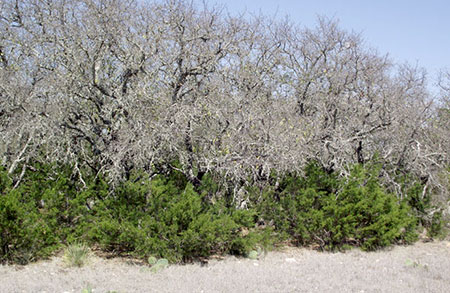
Extreme Fire
Our research team is developing models and conducting experimental manipulations to evaluate how variability in fire regimes have changed as a result of contemporary social-ecological constraints and how these feedbacks influence alternative state dynamics.
Learn More
Rangeland Management
Our research team is evaluating how alternative state theory is being applied within state and transition models in the ESD Database, with the intent of providing feedback that helps close the gap between theory and application in rangeland ecology and management.
Learn More
Conservation Trade-offs
Energy development, urbanization, agricultural conversion, afforestation, fuels management for wildfire protection, modifications of historical ecological disturbance regimes and their displacement by modern management systems - all land uses provide some tangible benefit to society but also result in trade-offs to other desirable ecosystem services. Our research team is developing projects that evaluate the benefits and trade-offs of different land uses and management techniques across a wide array of ecosystem services, with particular emphasis on endangered species and wildlife conservation, invasive species control, wildland fire and fuels management, and livestock production in rangelands.
Projects: Rangeland fuels management and prairie chicken conservation. (Funded by Joint Fire Sciences Program in collaboration with Utah State University and Oklahoma State University.)

Urban Fire Danger
The wildfire problem is growing in the central and western United States, and it is clear that greater awareness is needed to change societal practices promoting the wildfire problem and novel approaches to fuels management at the wildland-urban interface are necessary to protect human lives and infrastructure. Such fuels management strategies need to be ecologically sounds and minimize the impact of managing for one ecosystem service (fuels management and wildfire protection) at the major detriment to another (biodiversity). Our research team is increasing awareness on the factors contributing to fire danger at the wildland-urban interface throughout the Great Plains, working to increase the number of FIREWISE communities within states in the Great Plains, developing models to better understand spatiotemporal changes in rangeland fuels as a result of variability in weather and disturbance, and evaluating the potential effectiveness of fuels management strategies in rangeland ecosystems.
Projects: Dynamic vegetation models for grassland fuels under variable fire and grazing regimes. (Funded by Joint Fire Science Program in collaboration with Oklahoma State University.)
Community wildfire hazard and risk assessment – Final report for Stillwater, Okla. (PDF file, 21 MG)

Climate-Vegetation Forecasts
As society becomes confronted with more frequently occurring climatic extremes, it will become increasingly important to understand, predict and plan for major shifts in vegetation. Many regional planners rely on predictive climate models, such as species biometric climate models and dynamic global vegetation models (DGVMs), as the basis for understanding climate-induced shifts in vegetation and to develop mitigation efforts. However, model projections carry with them a great deal of uncertainty. Long-term experimental research sites provide an important source of data for testing and refining model predictions of climate-induced vegetation change. Using modeling and long-term data, our research team is developing and testing forecasts of vegetation change at scales ranging from individual land units to national-level projections.
Projects: Climate change induced risk of vegetation shifts for non-forested plant communities. (Funded by Department of Defense in collaboration with Oklahoma State University and University of Montana.)
Twidwell, D., C.L. Wonkka, C.A. Taylor, Jr., C.B. Zou, J.J. Twidwell, W.E. Rogers. 2013. Drought-induced woody plant mortality in an encroached savanna depends on topoedaphic factors and land management. Applied Vegetation Science DOI: 10.1111/avsc.12044.
